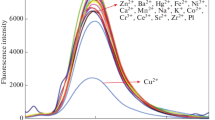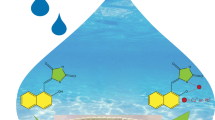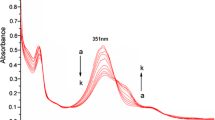Abstract
A pyridoxal-based fluorescent probe HL was synthesized for the detection of Cu2+ in methanol with moderate selectivity. Upon addition of Cu2+, to the solution of the probe in methanol exhibited a remarkable change in emission at 500 nm. With the limit of detection of 10 μM, the probe could well meet the recommended (less than 32 μM in drinking water) of the World Health Organization (WHO). The intracellular Cu2+ imaging behaviour of HL was carried out on HeLa cells.














Similar content being viewed by others
References
Gaggelli E, Kozlowski H, Valensin D, Valensin G (2006) Copper homeostasis and neurodegenerative disorders (Alzheimer’s, prion, and Parkinson’s diseases and amyotrophic lateral sclerosis. Chem Rev 106:1995–2044
Que EL, Domaille DW, Chang CJ (2008) Metals in neurobiology: probing their chemistry and biology with molecular imaging. Chem Rev 108:1517–1549
Radisky D, Kaplan J (1999) Regulation of transition metal transport across the yeast plasma membrane. J Biol Chem 274:4481–4484
Chan YH, Chen J, Liu Q, Wark SE, Son DH, Batteas JD (2010) Ultrasensitive copper(II) detection using plasmon-enhanced and photo-brightened luminescence of CdSe quantum dots. Anal Chem 82:3671–3678
Multhaup G, Schlicksupp A, Hesse L, Beher D, Ruppert T, Masters CL, Beyreuther K (1996) The amyloid precursor protein of Alzheimer’s disease in the reduction of copper(II) to copper(I). Science 271:1406–1409
Lovstad RA (2004) A kinetic study on the distribution of Cu(II)-ions between albumin and transferrin. BioMetals 17:111–113
World Health Organization (2011) Guidelines for drinking-water quality
Bings NH, Bogaerts A, Broekaert JAC (2008) Anal Chem 80:4317–4347
Siripinyanond A, Worapanyanond S, Shiowatana J (2005) Field-flow fractionation-inductively coupled plasma mass spectrometry: an alternative approach to investigate metal-humic substances interaction. Environ Sci Technol 39:3295–3301
Tanyanyiwa J, Hauser PC (2002) High-voltage contactless conductivity detection of metal ions in capillary electrophoresis. Electrophoresis 23:3781–3786
Xiang Y, Tong AJ, Jin PY, Ju Y (2006) New fluorescent rhodamine hydrazone chemosensor for Cu(II) with high selectivity and sensitivity. Org Lett 8:2863–2866
Huang CC, Yang Z, Lee KH, Chang HT (2007) Synthesis of highly fluorescent gold nanoparticles for sensing mercury(II). Angew Chem Int Ed 46:6824–6828
Sirilaksanapong S, Sukwattanasinitt M, Rashatasakhon P (2012) 1,3,5-Triphenylbenzene fluorophore as a selective Cu2+ sensor in aqueous media. Chem Commun 48:293–295
Huang L, Cheng J, Xie KF, Xi PX, Hou FP, Li ZP, Xie GQ, Shi YJ, Liu HY, Bai DC, Zeng ZZ (2011) Cu(2+)-selective fluorescent chemosensor based on coumarin and its application in bioimaging. Dalton Trans 40:10815–10817
Wampler JE, Churchich JE (1969) Phosphorescence of pyridoxal. J Biol Chem 244:1477–1480
Eliot AC, Kirsch JF (2004) Pyridoxal phosphate enzymes: mechanistic, structural, and evolutionary considerations. Annu Rev Biochem 73:383–415
John RA (1995) Pyridoxal phosphate-dependent enzymes. Biochim Biophys Acta 1248:81–96
Toney MD (2005) Reaction specificity in pyridoxal phosphate enzymes. Arch Biochem Biophys 433:279–287
Christen P, Metzler DE (1985) Transaminases. Wiley, New York
Hayashi H, Mizuguchi H, Miyahara I, Islam MM, Ikushiro H, Nakajima Y, Hirotsu K, Kagamiyama H (2003) Strain and catalysis in aspartate aminotransferase. Biochim Biophys Acta 1647:103–109
Liu W, Peterson PE, Langston JA, Jin X, Zhou X, Fisher AJ, Toney MD (2005) Kinetic and crystallographic analysis of active site mutants of Escherichia coli gamma-aminobutyrate aminotransferase. Biochemistry 44:2982–2992
Fogle EJ, Liu W, Woon ST, Keller JW, Toney MD (2005) Role of Q52 in catalysis of decarboxylation and transamination in dialkylglycine decarboxylase. Biochemistry 44:16392–16404
Sun S, Toney MD (1999) Evidence for a two-base mechanism involving tyrosine-265 from arginine-219 mutants of alanine racemase. Biochemistry 38:4058–4065
Watanabe A, Yoshimura T, Mikami B, Hayashi H, Kagamiyama H, Esak NJ (2002) Reaction mechanism of alanine racemase from bacillus stearothermophilus: X-ray crystallographic studies of the enzyme bound with n-(5′-phosphopyridoxyl)alanine. Biol Chem 277:19166–19172
Major DT, Gao J (2006) A combined quantum mechanical and molecular mechanical study of the reaction mechanism and alpha-amino acidity in alanine racemase. J Am Chem Soc 128:16345–16357
Schirch V, Szebenyi DME (2005) Serine hydroxymethyltransferase revisited. Curr Opin Chem Biol 9:482–487
Paiardini A, Contestabile R, Aguanno SD, Pascarella S, Bossa F (2003) Threonine aldolase and alanine racemase: novel examples of convergent evolution in the superfamily of vitamin B6-dependent enzymes. Biochim Biophys Acta 1647:214–219
Brazeau BJ, Johnso BJ, Wilmot CM (2004) Copper-containing amine oxidases. Biogenesis and catalysis; a structural perspective. Arch Biochem Biophys 428:22–31
Mure M, Mills SA, Klinman JP (2002) Catalytic mechanism of the topa quinone containing copper amine oxidases. Biochemistry 41:9269–9278
Smith AT, Majtan T, Freeman KM, Su Y, Kraus JP, Burstyn JN (2011) Cobalt cystathionine β-synthase: a cobalt-substituted heme protein with a unique thiolate ligation motif. Inorg Chem 50:4417–27
Prior FGR (1985) Theoretical involvement of vitamin B6 in tumour initiation. Med Hypotheses 16:421–428
Bender DA, Bowden JF, Coulsen WF, Dewji MR, Sutton J, Symes EK (1988) Current topics in nutrition and disease: clinical and physiological applications of vitamin B6, New York, U.S.A.
Snell EE (1945) The vitamin B6 group. V. The reversible interconversion of pyridoxal and pyridoxamine by transamination reactions. J Am Chem Soc 67:194–197
Guirard BM, Snell EE (1981) In: Florkin M, Stotz EH (eds) Comprehensive Biochemistry. Elsevier, Amsterdam
Mehansho H, Henderson LM (1980) Transport and accumulation of pyridoxine and pyridoxal by erythrocytes. J Biol Chem 255:11901–11907
Casella L, Gullotti M (1983) Coordination modes of histidine. 6. Transamination in the 2-formylpyridine-amino acid-metal ion systems. Stereochemistry of zinc(II) and copper(II) complexes of N-(2-pyridylmethylidene)amino acids. Inorg Chem 22:2259–2266
Walsh C (1978) Chemical approaches to the study of enzymes catalyzing redox transformations. Annu Rev Biochem 47:881–931
Vederas JC, Floss HG (1980) Stereochemistry of pyridoxal phosphate catalyzed enzyme reactions. Acc Chem Res 13:455–463, and references therein
Walsh C, Pascal RA, Johnson M, Raines R, Dikshit D, Krantz A, Honna M (1981) Mechanistic studies on the pyridoxal phosphate enzyme 1-aminocyclopropane-1-carboxylate deaminase from Pseudomonas sp. Biochemistry 20:7509–7519
Koh LL, Ranford JO, Robinson WT, Svensson JO, Tan ALC, Wu D (1996) Model for the reduced schiff base intermediate between amino acids and pyridoxal: copper(II) complexes of N-(2-hydroxybenzyl)amino acids with nonpolar side chains and the crystal structures of [Cu(N-(2-hydroxybenzyl)-D,L-alanine)(phen)].H2O and [Cu(N-(2-hydroxybenzyl)-D,L-alanine)(imidazole)]. Inorg Chem 35:6466–6472
Metzler DE, Longenecker JB, Snell EE (1953) Reversible catalytic cleavage of hydroxyamino acids by pyridoxal and metal salts. J Am Chem Soc 75:2786–2787
Metzler DE, Olivard J, Snell EE (1954) Transamination of pyridoxamine and amino acids with glyoxylic acid. J Am Chem Soc 76:644–648
Metzler DE, Snell EE (1952) Some transamination reactions involving vitamin B6. J Am Chem Soc 74:979–983
Longenecker JB, Snell EE (1957) The comparative activities of metal ions in promoting pyridoxal-catalyzed reactions of amino acids. J Am Chem Soc 79:142–145
Matsushima Y, Martell AE (1967) Pyridoxal analogs. IX. Electron absorption spectra and molecular species in methanol solution. J Am Chem Soc 89:1322–1330
Abbott EH, Martell AE (1969) Nuclear magnetic resonance investigation of the metal ion and proton-catalyzed reaction of some vitamin B6 Schiff bases. J Am Chem Soc 91:6931–6939
Wagner MR, Walker FA (1983) Spectroscopic study of 1:1 copper(II) complexes with Schiff base ligands derived from salicylaldehyde and L-histidine and its analogs. Inorg Chem 22:3021–3028
Snell EE, Braunstein AE, Severin ES, Torchinsky YM (1968) Eds. Pyridoxal Catalysis: Enzymes and Model Systems; Interscience: NewYork
Holm RH (1973) In: Eichhorn GL (ed) Inorganic biochemistry. Elsevier, New York
Martell AE (1973) In: Sigel H (ed) Metal ions in biological systems, vol 2. Dekker, New York
Naskar S, Naskar S, Butcher RJ, Chattopadhyay SK (2010) Synthesis, X-ray crystal structures and spectroscopic properties of two Ni (II) complexes of pyridoxal Schiff’s bases with diamines: Importance of steric factor in stabilization of water helices in the lattices of metal complex. Inorg Chim Acta 363:404–411
Naskar S, Naskar S, Figgie HM, Sheldrick WS, Chattopadhyay SK (2010) Synthesis, crystal structures and spectroscopic properties of two Zn(II) Schiff’s base complexes of pyridoxal. Polyhedron 29:493–499
Abbott EH, Martell AE (1970) Mechanism of formation, structure, stereochemistry, and racemization of bis[pyridoxylidene(amino acidato)]aluminum(III) complexes. J Am Chem Soc 92:5845–5851
Martell AE, Eidson AF (1975) Absorption and circular dichroism spectra of the pyridoxylidenalanatoaluminum (III) complex. Bioinorg Chem 4:277–289
Capasso S, Giordano F, Mattia C, Mazzarella L, Ripamonti A (1974) Stereochemistry of model compounds for pyridoxal-catalysed reactions. Crystal structures of the hydrated complexes bis(pyridoxylidene-DL-valinato)nickel(II) and bis(pyridoxylidene-L-valinato)zinc(II). J Chem Soc Dalton Trans 2228–2233
Pessoa CJ, Cavaco I, Correia I, Duarte MT, Gillard RD, Henriques RT, Higes FJ, Madeira C, Tomaz I (1999) Preparation and characterisation of new oxovanadium(IV) Schiff base complexes derived from amino acids and aromatic o-hydroxyaldehydes. Inorg Chim Acta 293:1–11
Shanbhag VM, Martell AE (1990) Schiff bases of pyridoxal 5′-phosphate and 5′-deoxypyridoxal with phenylglycine derivatives and their metal complexes. Inorg Chem 29:1023–1031
Correia I, Pessoa CJ, Duarte MT, Henriques RT, Piedade MFM, Veiros LF, Jakusch T, Kiss T, Dörnyei Á, Castro MMCA, Geraldes CFGC, Avecilla F (2004) N, N’-Ethylenebis(pyridoxylideneiminato) and N, N’-Ethylenebis(pyridoxylaminato): Synthesis, Characterization, Potentiometric, Spectroscopic, and DFT Studies of Their Vanadium(IV) and Vanadium(V) Complexes. Chem Eur J 10:2301–2317
Correia I, Dörnyei Á, Avecilla F, Kiss T, Pessoa CJ (2006) X-ray crystal structure and characterization in aqueous solution of {N, N-ethylenebis(pyridoxylaminato)}zinc(II). Eur J Inorg Chem 3:656–662
Sundaravel K, Suresh E, Palaniandavar M (2009) Synthesis, structures, spectral and electrochemical properties of copper(II) complexes of sterically hindered Schiff base ligands. Inorg Chim Acta 362:199–207
Adao P, Maurya MR, Kumar U, Avecilla F, Henriques RT, Kusnetsov ML, Pessoa CJ, Correia I (2009) Vanadium-salen and -salan complexes: characterization and application in oxygen transfer reactions. Pure Appl Chem 81:1279–1296
Mukherjee T, Pessoa JC, Kumar A, Sarkar AR (2011) Oxidovanadium(IV) schiff base complex derived from vitamin B6: synthesis, characterization, and insulin enhancing properties. Inorg Chem 50:4349–4361
Mauryaa MR, Bishta M, Avecilla F (2011) Synthesis, characterization and catalytic activities of vanadium complexes containing ONN donor ligand derived from 2-aminoethylpyridine. J Mol Catal A Chem 344:18–27
Mandal S, Modak R, Goswami S (2013) Synthesis and characterization of a copper(II) complex of a ONN donor schiff base ligand derived from pyridoxal and 2-(pyrid-2-yl)ethylamine – a novel pyridoxal based fluorescent probe. J Mol Struct 1037:352–360
Mossman T (1983) Rapid colorimetric assay for cellular growth and survival. J Immunol Methods 65:55–63
Mandal S, Naskar B, Modak R, Sikdar Y, Chatterjee S, Biswas S, Mondal Kumar T, Modak D, Goswami S (2015) Syntheses, crystal structures, spectral study and DFT calculation of three new copper(II) complexes derived from pyridoxal hydrochloride, N, N-dimethylethylenediamine and N, N- diethylethylenediamine. J Mol Struct 1088:38–49
Swamy KMK, Kim HN, Soh JH, Kim Y, Kim SJ, Yoon J (2009) Manipulation of fluorescent and colorimetric changes of fluorescein derivatives and applications for sensing silver ions. Chem Commun 1234–1236
Benesi HA, Hildebrand JH (1949) A spectrophotometric investigation of the interaction of iodine with aromatic hydrocarbons. J Am Chem Soc 71:2703–2707
Hou F, Cheng J, Xi P, Chen F, Huang L, Xie G, Shi Y, Liu H, Bai D, Zeng Z (2012) Recognition of copper and hydrogen sulfide in vitro using a fluorescein derivative indicator. Dalton Trans 41:5799–5804
Liu Z-C, Yang Z, Li T, Wang B, Li Y, Qin D, Wang M, Yan M (2011) An effective Cu(II) quenching fluorescence sensor in aqueous solution and 1D chain coordination polymer framework. Dalton Trans 40:9370–9373
Wu SP, Huang ZM, Liu SR, Chung PK (2012) A pyrene-based highly selective turn-on fluorescent sensor for copper(II) ion and its application in live cell imaging. J Fluoresc 22:253–259
Kavallieratos K, Rosenberg JM, Che W–Z, Ren T (2005) Fluorescent sensing and selective Pb(II) extraction by a dansylamide ion-exchanger. J Am Chem Soc 127:6514–6515
Acknowledgments
Financial support from the University Grants Commission for senior research fellowship to S. Mandal [Sanction No. UGC/847/Jr. Fellow (Upgradation)] is gratefully acknowledged. SKM is grateful to DST-PURSE PROGRAMME for partial financial support of the biological work.
Author information
Authors and Affiliations
Corresponding author
Rights and permissions
About this article
Cite this article
Mandal, S., Mandal, S.K., Khuda-Bukhsh, A.R. et al. Pyridoxal Based Fluorescent Chemosensor for Detection of Copper(II) in Solution With Moderate Selectivity and Live Cell Imaging. J Fluoresc 25, 1437–1447 (2015). https://doi.org/10.1007/s10895-015-1634-x
Received:
Accepted:
Published:
Issue Date:
DOI: https://doi.org/10.1007/s10895-015-1634-x




